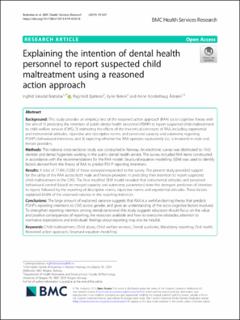| dc.contributor.author | Brattabø, Ingfrid Vaksdal | |
| dc.contributor.author | Bjørknes, Ragnhild | |
| dc.contributor.author | Breivik, Kyrre | |
| dc.contributor.author | Åstrøm, Anne Nordrehaug | |
| dc.date.accessioned | 2020-03-25T14:37:02Z | |
| dc.date.available | 2020-03-25T14:37:02Z | |
| dc.date.created | 2019-08-30T13:08:56Z | |
| dc.date.issued | 2019 | |
| dc.identifier.issn | 1472-6963 | |
| dc.identifier.uri | https://hdl.handle.net/11250/2648644 | |
| dc.description.abstract | Background
This study provides an empirical test of the reasoned action approach (RAA) socio-cognitive theory with the aim of 1) predicting the intention of public dental health personnel (PDHP) to report suspected child-maltreatment to child welfare services (CWS); 2) estimating the effects of the theoretical constructs of RAA, including experiential and instrumental attitudes, injunctive and descriptive norms, and perceived capacity and autonomy regarding PDHP’s behavioural intentions; and 3) exploring whether the RAA operates equivalently (i.e., is invariant) in male and female providers.
Methods
This national cross-sectional study was conducted in Norway. An electronic survey was distributed to 1542 dentists and dental hygienists working in the public dental health service. The survey included RAA items constructed in accordance with the recommendations for the RAA model. Structural equation modelling (SEM) was used to identify factors derived from the theory of RAA to predict PDHP reporting intentions.
Results
A total of 77.8% (1200) of those surveyed responded to the survey. The present study provided support for the utility of the RAA across both male and female providers in predicting their intention to report suspected child-maltreatment to the CWS. The final modified SEM model revealed that instrumental attitudes and perceived behavioural control (based on merged capacity and autonomy parameters) were the strongest predictors of intention to report, followed by the reporting of descriptive norms, injunctive norms and experiential attitudes. These factors explained 63.6% of the observed variance in the reporting intention.
Conclusions
The large amount of explained variance suggests that RAA is a well-functioning theory that predicts PDHP’s reporting intentions to CWS across gender, and gives an understanding of the socio-cognitive factors involved. To strengthen reporting intention among dental personnel, this study suggests educators should focus on the value and positive consequences of reporting, the resources available and how to overcome obstacles; attention to normative expectations and individuals’ feelings about reporting may also be helpful. | |
| dc.language.iso | eng | |
| dc.rights | CC BY 4.0 | |
| dc.rights.uri | https://creativecommons.org/licenses/by/4.0/ | |
| dc.title | Explaining the intention of dental health personnel to report suspected child maltreatment using a reasoned action approach | |
| dc.type | Peer reviewed | |
| dc.type | Journal article | |
| dc.description.version | publishedVersion | |
| cristin.ispublished | true | |
| cristin.fulltext | original | |
| cristin.qualitycode | 2 | |
| dc.identifier.doi | 10.1186/s12913-019-4330-8 | |
| dc.identifier.cristin | 1720100 | |
| dc.source.journal | BMC Health Services Research | |
| dc.source.volume | 19 | |

